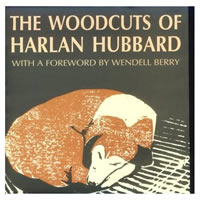Book Notes
 Harlan Hubbard, The Woodcuts of Harlan Hubbard, with a foreword by Wendell Berry (Lexington: University Press of Kentucky, 1994), 192pp.
Harlan Hubbard, The Woodcuts of Harlan Hubbard, with a foreword by Wendell Berry (Lexington: University Press of Kentucky, 1994), 192pp.
The artist-writer Harlan Hubbard (1900–1988) was born in Bellevue, Kentucky. When he was fifteen, his mother moved their family to New York City, where he went to high school in the Bronx. He later attended the National Academy of Design and the Art Academy of Cincinnati. At age nineteen he returned to Kentucky, where he spent the remainder of his remarkably singular life, and which he documented in his journals of nearly sixty years (1929–1987). In 1943 Hubbard married Anna Eikenhout. The next year he built a shanty boat on which they traveled down the Ohio and Mississippi rivers for eight years, a story he tells in his two books Shantyboat (1953) and Shantyboat on the Bayous (1990).
After eight-years of river rafting, the Hubbards built their own house at Payne Hollow, on the banks of the Ohio River in Trimble County, Kentucky. There, as told in his book Payne Hollow: Life on the Fringe of Society (1974), they lived a life of isolated independence and radical self-sufficiency, with no running water, plumbing, or electricity. Whereas Thoreau spent two years at Walden Pond, the Hubbards spent thirty-four years at Payne Hollow, chopping fire wood, tending goats, gathering nuts, fishing, weaving, scavenging the banks of the Ohio River, playing the violin and piano, and growing their own food. In his biography, Harland Hubbard: Life and Work, Wendell Berry writes how Hubbard "had a Blakean horror of the industrial mind and its products. He knew better than to believe that he could escape the influence of that mind or even put himself safely beyond its reach. But he meant certainly to distinguish himself and his life from it; he meant to keep himself at some distance from it. He had in his mind and body the wherewithal to do that, and to a remarkable extent he succeeded.”
Hubbard was best known as an artist who painted over 2500 works in oil, acrylic, and especially watercolor. He also produced about 180 prints from woodcuts. This book contains about half of those known woodcuts, most of which have never been published. The woodcuts are a bit of an unknown of Hubbard's legacy. He wrote much in his journals about his painting, but hardly anything about his print making. We don't know the chronological order of the woodcuts, and so their arrangement in the book is necessarily arbitrary. He almost never gave the prints titles. Some are signed, but most are not. Like his paintings, the woodcuts are mainly landscapes of his beloved Ohio River environs. Many are of boats — barges, tow boats, steam boats, shrimp trawlers, a ferry, his skiff, and many shanty boats. Most of the cuts were made from pieces of wood that Hubbard had salvaged.
In his journal entry for April 8, 1963, Hubbard wrote, "I work alone, who cares whether I produce anything or not, or who appreciates it? Yet I believe a good thing will not perish." This wonderful collection of woodcuts from such a singular person is a testament to that truth.


